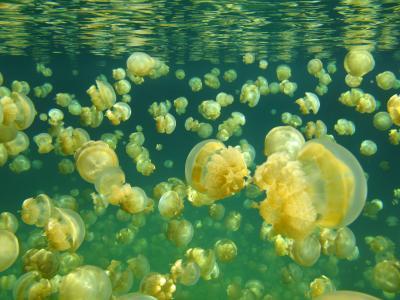Scientists have been thinking increasingly about whether or not animals in the ocean might play a role in larger-scale ocean mixing, says John Dabiri, a Caltech bioengineer. Ocean mixing is the process by which various layers of water interact with one another to distribute heat, nutrients and gasses throughout the oceans.
"The perspective we usually take is how the ocean--by its currents, temperature, and chemistry--is affecting animals," says Dabiri, who, along with graduate student Kakani Katija, discovered the new mechanism. "But there have been increasing suggestions that the inverse is also important, how the animals themselves, via swimming, might impact the ocean environment."
Dabiri's and Katija's findings show this inverse to be true, and are published in the journal Nature.Oceanographers had previously dismissed the idea that animals might have a significant effect on ocean mixing, believing that the viscosity of water would cancel out any turbulence created, especially by small planktonic, or drifting, animals.
But Dabiri and Katija thought there might be a mechanism that had been overlooked, a mechanism they call Darwinian mixing, because it was first discovered and described by Darwin's grandson.

This image shows a view of Jellyfish Lake in Palau, with golden jellyfish "biomixing" the waters. (Photo Credit: Michael Dawson, University of California at Merced)
"Results from this study will change some of our long-held conceptions about mixing processes in the oceans," says David Garrison, director of NSF's biological oceanography program.
"Darwin's grandson discovered a mechanism for mixing similar in principle to the idea of drafting in aerodynamics," Dabiri explains. "In this mechanism, an individual organism literally drags the surrounding water with it as it goes."
Darwin's mechanism suggests that they drag some of the colder, heavier bottom water up with them toward warmer, lighter water at the top. This would create instability, and eventually, the water would flip, mixing itself as it went.
Using this idea as their basis, Dabiri and Katija performed mathematical simulations of what might happen if many small animals all moved at the same time, in the same direction. Each day, for example, billions of tiny krill and copepods migrate hundreds of meters from the depths of the ocean toward the surface.
The researchers found that the water's viscosity actually enhances Darwin's mechanism, and that the effects are magnified with very small animals like krill and copepods.
"It's like a human swimming through honey," Dabiri explains. "What happens is that even more fluid ends up being carried by a copepod, relatively speaking, than would be carried by a whale."
To verify the findings from their simulations, the scientists traveled to the island of Palau, where they studied animal-led transport of water--otherwise known as induced drift--among jellyfish. Their jellyfish experiments involved putting fluorescent dye in the water in front of the jellies, then watching what happened to that dye and to the water that took up the dye as the jellyfish swam.Rather than being left behind the jellyfish, or dissipated in strong currents, the dye traveled alongside the jellyfish for long distances. The findings verified that swimming animals are capable of carrying bottom water with them as they migrate upward, and that the movement does creates an inversion that results in ocean mixing.
After a series of calculations, Dabiri and Katija were able to estimate the impact of this biogenic ocean mixing. "There are enough of these animals in the ocean," Dabiri says, "that the global power input from this process is as much as a trillion watts of energy, comparable to that of wind forcing and tidal forcing."While these numbers are estimates, they are likely to be conservative estimates, Dabiri says. "They were based on the fluid transport induced by individual animals swimming in isolation."
In the ocean, these individual contributions to fluid transport may interact with one another, and amplify how far ocean waters can be pulled upward. Dabiri also says scientists have yet to consider the effects of such factors as fecal pellets and marine snow (falling organic debris), which pull surface water along as they drift downward."This may have an impact on carbon sequestration on the ocean floor," says Dabiri. "It's something we need to look at."





Comments